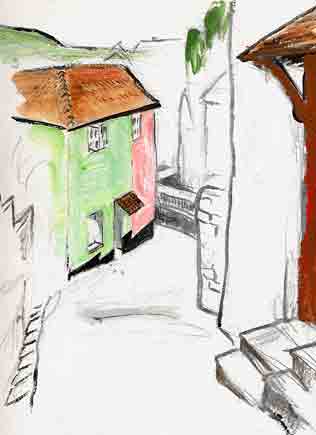|
The name of this lane preserves the oldest moment in the known history of Lyme. Sherborne is a town thirty road-miles away at the northern edge of Dorset. (Its Anglo-Saxon name, first recorded as Scireburnan, means “bright stream”; it lies in the upper valley of the River Yeo.) It had an abbey, to which in 774 king Cynewulf of Wessex granted a manor and salt rights (that is, a piece of land and the rights to salt panned from the sea) on the west bank of the river Lim. Some of them must have been sent down to live here and work the salt. They had been sent to the wild west frontier: at that time the kingdom of the West Saxons, with its capital at Winchester, had yet to conquer the Britons of Devon and Cornwall.
This was the Cynewulf who, according to the Anglo-Saxon chronicle, was in 786 slain at Merton in Surrey — or possibly a similarly named place in Wiltshire, by his relative Cyneard — who then was killed by Cynewulf's followers and was buried at Axminster.
What is amazing is that Sherborne Lane, now so near to the centre of the town, was once its outer bound. Indeed, the houses along its left or west side, their backs facing uphill, were probably the town's defensive line against the Royalist besiegers in 1644.
Most of those old houses have been replaced. But the first segment on the right is a sequence of what evidently used to be five old cottages in a descending row. They were merged to make the Mad Hatter restaurant. You could peer down from Broad Street into the first room, where people sat with their heads at street-level; then, inside, a passage ran past successively lower rooms which were once the little cottages. The restaurant, after some decades of flourishing, folded and was replaced by a flower shop, the rest becoming again a sort of cottages.
On the left upper corner of the lane a ramp ascends to the Baptist church. The house next to it is what was the Baptist Manse until 2006. Then we came from Uplyme to live in it, and our large red wooden lion attracts attention in its front window. We remodeled the front area, also the small steep garden behind, in which we dug up an iron cannon-ball, the size of a tennis-ball (three inches) but weighing three pounds. It could have been one of those lobbed onto the town in the siege of 1644.
(On the morning when we were trying to move in, the entrance at the top was blocked by a service vehicle sent to scatter a load of sand. The night before, drunks coming from the pubs had taken vats of cooking oil left outside the restaurant's kitchen door and slung them down the lane, turning it into a greasy Cresta Run.)
On the left is a mixture of frontages that crowd the lane, and others set back behind pretty gardens. Only one of the cottages has retained its thatch. Old photographs show that many of them shared one dipping thatched roofline. Many of them had iron railings in front, which may have been sacrificed to the 1939-1945 war effort. The war, however, saved the cottages from demolition. They had been condemned because they lacked sanitation and running water.
The first tall lane-crowder, called Eagle House, used to be the mortuary, run by two brothers, and children used to hurry past the passage at the side of it, in which stacked caskets could be seen. Later it was a pancake restaurant. It was in ruinous condition when revived by its present owners (theirs is the sign of the Jiving Jellyfish T-shirts). It rambles back through several connected structures and a garden that is the only one in the lane to ramble on through to the next street.
At another point there is a semi-secret passage that leads through to other dwellings tucked behind, indeed provides a way for residents of Sherborne Lane to get to their cars in an otherwise distant car park.

Half way down, Sherborne Lane gets even narrower, also steeper, and was once a flight of steps. Doorsteps are now in hollows, showing that tarmacking has raised the lane's surface. On the left is a handrail — this is the only “street” steep and narrow enough, and at times slippery enough, to need this assistance for infirm pedestrians.

At the bottom, Sherborne Lane hits the river: that is, it hits the brick parapet overlooking the river, and bends left around a last tight group of cottages, to reach an open space.
|


